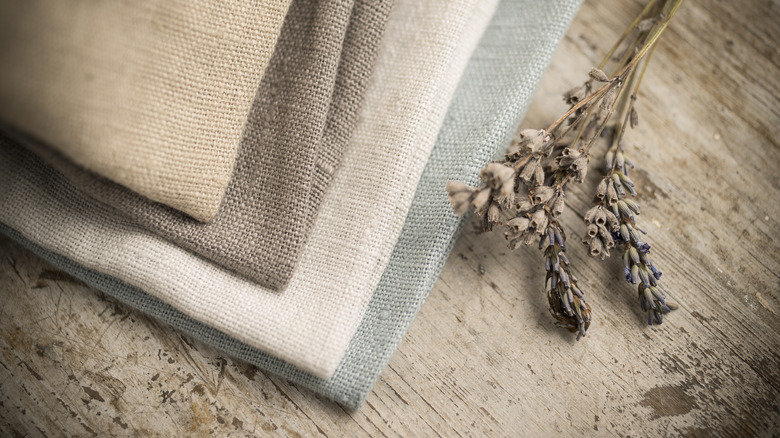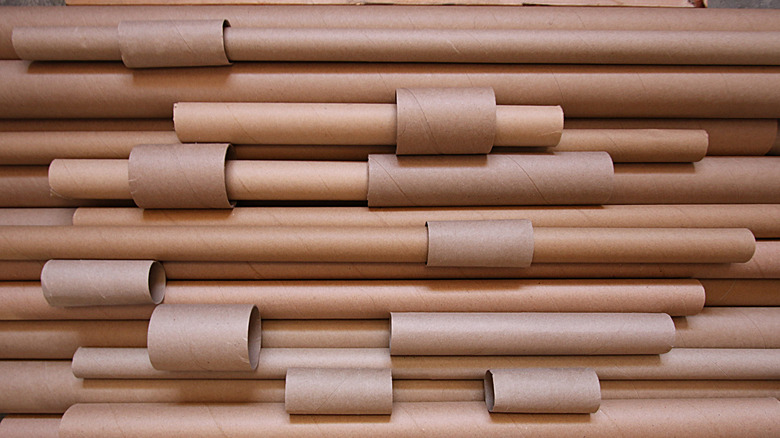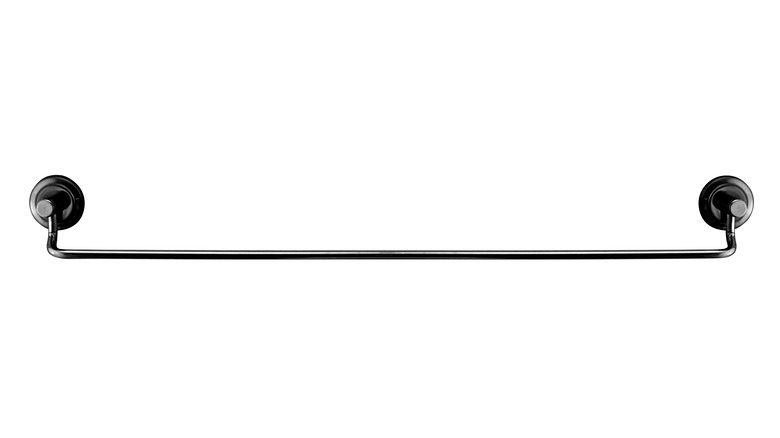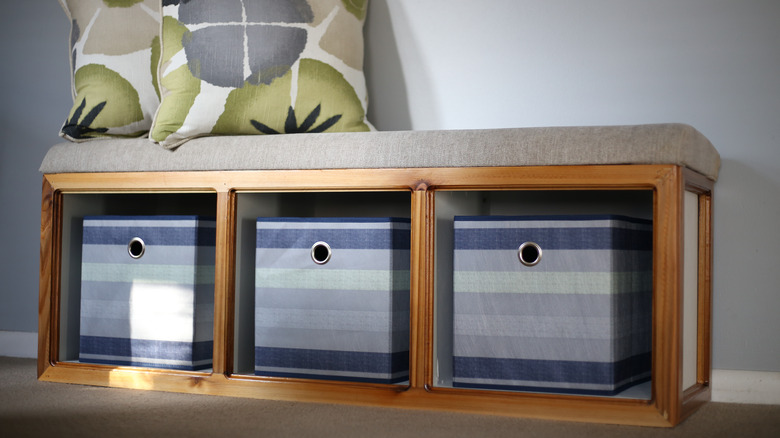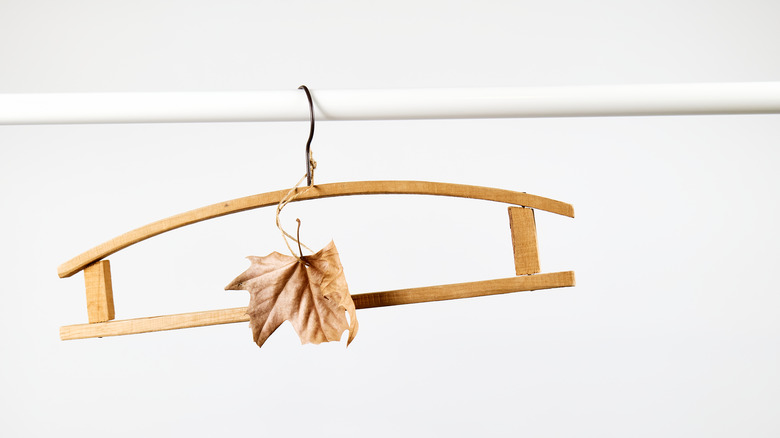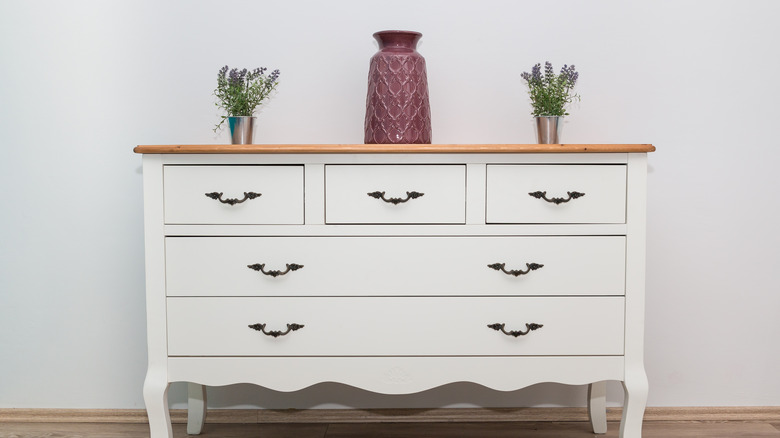5 Clever Ways To Store Your Tablecloths When Not In Use
All the lovely things we use to adorn our tables for special occasions need a place to go between those events. Small items such as napkin rings and candle holders can easily be stored in a drawer, but tablecloths take up more space. Folding them and keeping them tucked away in a stack of other things in the closet could work, but there are better, more clever ways to ensure they are out of the way when not in use but ready for the party at a beck and call.
Utopia Cleaners recommends laundering and drying tablecloths according to the care instructions listed on the fabric tag, noting that some are meant to be hand-washed only. Those that can be machine washed should be laundered on a gentle cycle setting. Also, transfer the linens promptly from the washing machine to the dryer if applicable, and remove them from the heat as soon as the cycle is complete. Now that your tablecloth is clean, you'll want to put it away in a way that keeps it as wrinkle- and crease-free as possible — we have some ideas.
1. Roll tablecloths around cardboard tubes
The Old Farmer's Almanac says tablecloths should never be folded unless necessary, and rolling them up prevents creases. Glyndon Lord Baltimore Cleaners recommends using cardboard tubes for this task, which come in a variety of thicknesses and lengths. These tubes can be found at craft stores, online, and in places where mail supplies are sold. This method works for any size and shape of a tablecloth but may require folding the linen in half, thirds, or quarters to fit the length of the roll. Utopia Cleaners stresses that the tube should be acid-free to not damage or discolor the fabric over time.
Carefully wrap the folded cloth around the tube, making sure to smooth out any bumps in the fabric as you go. Secure each end with safety pins or large paper clips when complete. Repeat with all of your tablecloths for easy storage. Tuck the rolls away in the back of a closet until you need them again, but make sure they are correctly stored so that they aren't pressed too firmly against other things to keep them from getting crimped. As a bonus, some tubes (mailing tubes) come with end caps that make it easy also to store matching linens and napkin rings.
2. Hang tablecloths on towel racks
Offbeatbros lists many creative ways to incorporate towel racks into your organization scheme, but one clever idea would work well with the cardboard tube storage method we mentioned above. First, find the back of a door or a closet where the towel bars will be installed. Make sure to follow the installation instructions contained with the bar, including using the correct anchors. Putting multiple linens on one rack can become excessively heavy, and you don't want it to rip out of the wall.
Technically, you could fold the tablecloths and drape them over the towel bars, as this would also be an effective way to store them out of the way. Still, they could hang vertically from the towel bar by wrapping and securing the linens to a cardboard tube and adding a hook to the end. The dangling tubes take up less room, require fewer towel bars, and will not be squished together.
3. Place folded tablecloths inside a covered bench
Functional and attractive, benches are a nifty addition to any dining room area. According to Vox Furniture, if you don't already own a storage bench, you should get one because they are incredibly adaptable and functional. Yes, they add seating, but the right style also adds much-needed hidden storage for things that would otherwise clutter up your home. They're available at any price point and perfect for small spaces and various design styles. Benches are a classic choice that has been popular for years, so you can buy new or find a vintage treasure at a local thrift shop.
Perhaps a bench with a hinged top that lifts to reveal ample storage space would be perfect for your folded tablecloths and their matching counterparts, or go with one with open shelving beneath the seat. Add baskets to hold your linens, and you'll have a stylish place for all your tablecloths. For folded tablecloths, Utopia Cleaners suggests placing acid-free tissue paper between the folds to prevent crisp folds.
4. Drape tablecloths over hangers
If you have room to spare in a closet, preferably in a guest room where the tablecloths won't get bustled much, folding your tablecloths and draping them over a hanger works well. Ensure the storage area is cool, dry, and away from direct sunlight. It's essential to allow linens to hang in a way that allows air to circulate between them so the fabric can breathe, preventing musty smells. Quality Logo Products recommends using padded hangers to minimize deep creases to the material that may be difficult to iron or steam out. Each hanger should support only one tablecloth, as doubling the linens will encourage wrinkles and creases.
Utopia Cleaners recommends removing the tablecloths from their hangers or drawers every few months to refold them. This helps retain freshness and avoid the development of permanent fold-lines from the pressure of the hanger.
5. Tuck tablecloths away in a vintage dresser or hutch
One fun way to jazz up your kitchen or dining room is with an antique or vintage cabinet, dresser, or hutch. Decorating it with paint or leaving it chippy can add to the design of your space while also creating storage solutions for tablecloths and other occasional items. This type of storage is versatile and decorative, allowing tablecloths to be packed with matching items, making them easy to locate when needed.
You'll want to clean the furniture well before placing your linens inside, especially if there's a musty smell. Get Smell Out recommends beginning your cleaning adventure with bleach and water to remove mold spores that have penetrated the wood. If the smell persists, they offer additional solutions. It's a good idea to line the drawers or shelves with acid-free tissue paper to protect linens from being in direct contact with wood surfaces, which can lead to discoloration. Also, remember to place this same type of tissue paper between the fold of the fabric as well.
